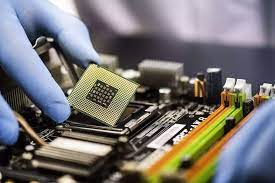Table of Contents
Foxconn, the Taiwanese electronics manufacturing giant, has withdrawn from a $19 billion joint venture with Indian mining conglomerate Vedanta to establish a semiconductor and display production plant in India. The decision was announced by the company in a statement on Monday, citing a desire to explore alternative development opportunities. The company did not provide specific reasons for its withdrawal, but reports suggest that the joint venture faced challenges in securing a technology partner to produce chips used in mobile phones.

The Timeline
The joint venture, initiated in 2022, aimed to construct a semiconductor and display production facility, with 60% ownership by Vedanta and 40% by Foxconn. The Taiwanese company, headed by billionaire Terry Gou, acknowledged that both parties had worked diligently for over a year to bring their semiconductor ambitions to fruition. However, they concluded that the project was not progressing as swiftly as anticipated, encountering obstacles that proved difficult to overcome.
Following Foxconn’s departure, efforts are underway to remove the company’s name from the joint venture entity, known as Vedanta Foxconn Semiconductors Ltd., to avoid confusion for future stakeholders. Vedanta, on the other hand, expressed its commitment to the semiconductor fab project and stated that it has identified alternative partners to establish India’s first foundry. The company emphasized its determination to align with Indian Prime Minister Narendra Modi’s vision for semiconductors and stressed the significance of India in reshaping global semiconductor supply chains.
Foxconn’s Comments
Despite the dissolution of the joint venture, Foxconn expressed confidence in India’s semiconductor development trajectory and reiterated its commitment to the country. The company highlighted its ongoing presence in India since 2006 and its belief in India’s ability to establish a robust semiconductor manufacturing ecosystem. Foxconn emphasized its dedication to supporting the Indian government’s “Make in India” initiative by investing in the country and forming diversified local partnerships.
Rajeev Chandrasekhar, India’s Minister of State for Electronics and Information Technology, took to Twitter to state that Foxconn’s withdrawal from the joint venture would not alter India’s semiconductor objectives. He emphasized that it allows both companies to independently pursue their strategies for the Indian semiconductor and electronics sectors.
Sources familiar with the matter revealed that Foxconn’s decision to withdraw from the joint venture may have been influenced by the Indian government’s inquiries into its application for an incentive scheme related to chip production. However, neither Foxconn nor Vedanta immediately responded to requests for comment on the matter.
The joint venture’s dissolution underscores the challenges associated with establishing semiconductor fabs in new regions. Nonetheless, Foxconn expressed its unwavering commitment to investing in India and supporting the government’s “Make in India” campaign. The company remains optimistic about the growth of India’s nascent semiconductor industry and anticipates continuing its long-term partnership with the country.
India’s Semiconductor Industry

As the global electronics manufacturing landscape evolves, India aims to strengthen its position in the semiconductor industry and reduce dependence on imports. The withdrawal of Foxconn from the joint venture may lead Vedanta to seek alternative partnerships to realize its semiconductor ambitions and contribute to India’s semiconductor self-reliance goals.
India’s semiconductor industry is poised for growth as the country strives to reduce reliance on imports and strengthen its domestic manufacturing capabilities. With initiatives like “Make in India” and increasing investments, India aims to establish a robust semiconductor ecosystem, attract global players, and become a significant player in the global semiconductor supply chain.













